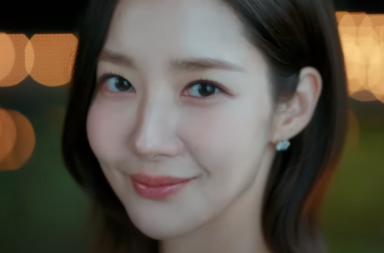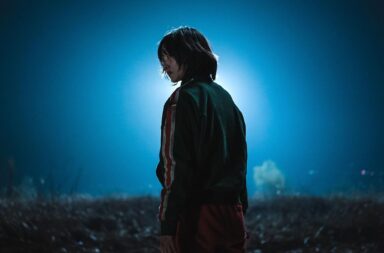There’s no denying it at this point: in 2022, South Korea is comfortably dominating the genre of the brutal horror parable. This may not always be via the undead (Squid Game and The Silent Sea are great examples outside the explicitly horrific), though it so often is. Kick-started by Train to Busan, much of the zombie renaissance (zombienaissance? Needs workshopping) from South Korea has come from Netflix productions. Unbridled by censorship that might reduce some of the violence possible on a traditional television channel, shows like Kingdom and Sweet Home (not technically zombie, but certainly adjacent) along with movies like #Alive, have used these monsters in thrilling, intelligent and savage ways.
The latest Netflix production to add to the zombie cannon is All Of Us Are Dead, a twelve-episode horror drama where ground zero for a particularly nasty virus is a high school. Based on the webtoon Now At Our School by Joo Dong-keun, the story follows a zombie outbreak across the various groups and personalities of the school and beyond to the surrounding city. Taking notes (sometimes explicitly) from its predecessors, this show pulls no punches in its use of blood and gore, and is often just as suspenseful and tense. Though it doesn’t do anything to reinvent the zombie wheel, and occasionally drags due to its run time, it is a well-constructed drama that earns its place in the blood-soaked South Korean horror halls of fame.
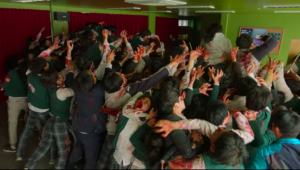
I use the term blood-soaked halls fairly literally with All Of Us Are Dead: this show, whilst dealing with younger protagonists than Train, Kingdom or #Alive, may be the most gruesome yet. The zombies in this show closely follow the model of these others—they move fast, they snarl, and their faces are messes of blood and veins. However, possibly the single most distinctive stroke of All Of Us is just how much they’ve extended their physicality. It may seem a strange point to open with, but, in a field that’s starting to get a little crowded, this show needed its own signature. They have it in two facets of the zombies’ characterisation: their movements as they become zombies, and the sounds they make.
The first of these, wild, contorting thrashings on the ground as limbs twist and bend, was actually professionally choreographed and learnt by all the actors. It’s a wonderful touch that really brings the body horror to the forefront of the narrative. These moves look agonising because they show the violence that is happening to the body.
The second part of this body horror is the sound that accompanies these movements, and subsequent twitchings that these undead characters make. Fingers, necks, arms and legs make impressively sickening cracking sounds as characters become infected. It’s another clever touch that shows the pain of what is happening to these people: they are being literally broken into monsters, and we can hear it.
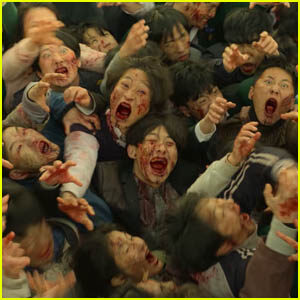
These extra layers of bodily pain show us zombies that are truly tortured into their state, which is actually how the entire story begins. We open with a swooping shot onto a rainy rooftop where a high school student is being ruthlessly bullied, driving him to attack before falling off the building and apparently suffering major injuries. However, when we meet the boy’s father, a weary, on-edge science teacher (Kim Byung-chul) at the hospital, his son is in a far more aggressive state, prompting his father to beat him into submission with a Bible before stuffing him into a suitcase.
As you can tell from this series opener, themes of despair, rage and injustice underlie this virus, from its cause to its symptoms. With these themes in mind, the setting of a high school, amid South Korea’s intense educational pressure, is the perfect petri dish. Beginning with a student who becomes infected after being bitten by one of the science teacher’s experimental mice (he is deeply involved with the virus’ inception himself), the virus soon spreads across classrooms, clubs, social divides and friendship groups.
Our main focus is on a group of juniors, including Nam On-jo (Park Ji-hoo), her long-term best friend Lee Cheong-san (Yoon Chan-young) and their various classmates. This core group of characters, including an isolated class president (Cho Yi-hyun), a nerdy academic (Ahn Seung-gyun), and a brattish rich kid (Squid Game’s Lee Yoo-mi), are brought together as much by external circumstance (studying together) as any other characters in zombie stories. However, the specific dynamic of school and teenagers does provide a different slant to what has gone before, in terms of pre-existing relationships.
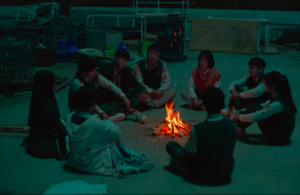
As with anything set in a high school, there are inevitable crushes, friendships and rivalries built into this group of students that form the backbone of our emotional engagement with them. We see Cheong-san pining for an oblivious On-jo, class president Nam-ra (Yi-hyun) emerge out of her shell as she works with her classmates to stay alive, and bratty Na-yeon (Yoo-mi) demonise and betray a student she deems unworthy as a kid on welfare. These relationships and their developments are what fuels the emotional core of this story, and, for the most part, the performances behind them are delivered well enough to create a real connection, one that feels all the more brutally severed when we start to lose characters to the virus.
That is not to say that these are the only characters in this story. Whilst the Hyosan High School juniors are the protagonists, the show largely does a good job in weaving in several other groups that we follow across the series. These include a secondary group of school survivors, On-jo’s father (Jeon Bae-soo) and the political team he was helping in his role as a firefighter whilst a city-wide emergency was declared, and a detective who is trying to find access to a laptop that may provide the key to stopping the virus.
The writing is balanced enough to turn to each of these characters at thematically relevant points, for example, to the father in scenes that need to demonstrate the wider impact of the virus outside of the school. However, these multiple narratives do hit the stumbling block that this structure eventually will: it draws your attention to which stories and characters are stronger, and which are weaker.
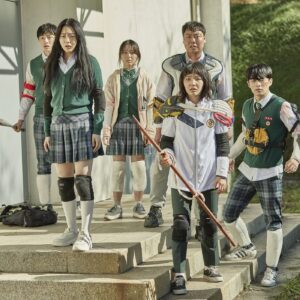
This is most evident in the scenes with the secondary group of school survivors, a group of seniors led by archer Ha-ri (Ha Seung-ri) and sarcastic, cynical smoker Mi-jin (Lee Eun-saem). Whilst the junior characters are charming and engaging enough within their own dynamics, the wit from Mi-jin, jaded from the impossibilities of high school expectation, and the resourceful badassery of Ha-ri with her level-headed shooting skills, is instantly more entertaining. It does lead episodes in the latter half of the series to be filled with expectation for their scenes, and a sense of distraction from what the juniors are doing. This narrative flaw is resolved, rather obviously, as the two groups eventually meet and team up, but it’s a small misstep to introduce secondary characters with more appeal than the main ones.
These two groupings did also highlight the most problematic element of our core group of juniors: gender differences. In many of the earlier scenes involving fighting and fleeing from zombies, the male students are at the forefront, battering zombies and barricading them from coming any further, while the girls stand back and cower. All exploratory missions the group needs to undertake are only volunteered by boys, and it is not until much later in the show (with the aid of things like weaponry and supernatural abilities) that the female characters become more active agents in fighting for their own survival.
Of course, this does not mean that physical brute force is the only way to defend oneself, or that female characters can never be scared or weak, especially when they’re children. But it did feel like an unfortunate writing decision that all of our core female characters needed constant male defence. It would have been exciting to see them break the mould a little more here.

Speaking of bending expectation, there is little here in terms of plotting that deviates in any great way from the classic beats of zombie apocalypses. At this point, with the over-saturation of the genre in general, this is not necessarily a big criticism. It’s hard to bring something truly new to a monster second only to the vampire in terms of prevalence. So, there are of course ever-dwindling numbers of survivors, emotional gut-punches as beloved ones realise they are about to turn, and seemingly random skill sets that turn out to be awfully helpful (you’re an archer you say? Fancy that!). It also means that certain genre inconsistencies don’t get resolved here. Exactly how much biting is needed for turning vs death, or how long people can survive without food or water, is missed in the larger scheme of things. Regardless of this, these story beats are hit with enough well-built tension and suspenseful set pieces as to not become boring.
Many of these set pieces involve attempts to move across areas infested with zombies, and are notable in how well choreographed they are in several respects. Firstly, the stunt work, particularly in fighting sequences, is realistic in its messiness and dynamism. On a grander scale, key scenes are orchestrated seamlessly to build maximum thrill and terror, such as the initial (literal) pile-up of zombie students bursting into the cafeteria in episode one, or Cheong-san’s fight with bully Gwi-nam (Yoo In-soo) atop library bookshelves in episode five. The geography of these scenes is laid out by innovative camerawork, which uses techniques like POV shots, skewed angles and sweeping overhead shots to give the audience the various levels of detail about this world.
The makeup and effects are also as developed here as they have been in Netflix’s other monster shows, with the blood, veins and boils dripping from infected faces that scream right at the camera lens without losing any authenticity. There is also a fantastically gory commitment to viscera throughout All Of Us: insides come out, faces get chewed, and body parts are openly strewn everywhere. Again, this feels like a deepening of the commitment to making these zombies truly horrifying, which, in combination with their movements, is strikingly effective.
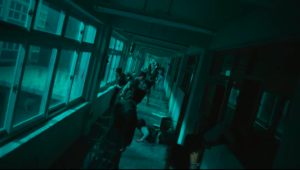
It is a compliment to the richness of the mythos All Of Us creates around the virus, its origins and its effects that it can’t all be summarised here. It is noble that this is attempted as well as it is, given how hard it is for the origins of terror to be as satisfying as their conclusions. The show does give a good examination of human responses to viral outbreaks and how cruel they can be (sound familiar?), along with a properly Frankensteinian scientist who is horrified and yet awed by his creation. It even goes so far as to consider hybridisation, a consequence that has wildly different impacts on characters such as the key villain Gwi-nam, and junior class president Nam-ra. There are also subtle mentions of Covid-19 in the background to tie all of what we watch to parallels in our own world, which is remarkable given that the original webtoon material is over ten years old.
Ultimately, All Of Us Are Dead is a welcome extension of Korean zombie horror into the world of high schools. Showing its teeth through confidently gory, thrashing zombie creatures and a well-fleshed out virus storyline, it is an engaging romp, if not an entirely original one. Despite small problems with the core cast, they are a likeable group of characters, who only become more so when their group is expanded and challenges heightened. Beautifully shot, pulsing with tense scenes and emotion, All Of Us Are Dead ironically breathes yet more life to the most undead of horror genres.
(Stream Wars, Images via Netflix.)

